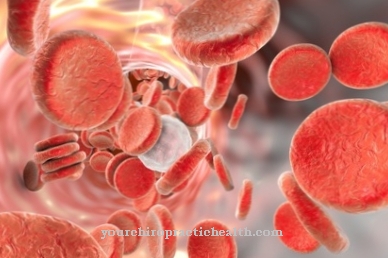Dihydralazine is an antihypertensive agent used to treat arterial hypertension. The exact molecular mode of action is not known. A main area of application is the regulation of blood pressure in severe preclampsia.
What is dihydralazine?

Dihydralazine is a pharmacological agent that is used against high arterial blood pressure. The active ingredient ensures the expansion of the arteries and arterioles in the smooth muscles, which reduces the peripheral resistance to blood flow.
Dihydralazine is a solid made up of orange needles. It is available in Germany under the trade names Nepresol® and Depressan®. Nepresol® and Depressan® are medicines for lowering blood pressure and are used in particular in the case of a severe course of high blood pressure.
The main area of application is preclampsia in patients with a pregnancy that is characterized by severe high blood pressure and edema.
Dihydralazine consists of an aromatic benzene ring, which is connected to a hetero ring made of carbon and nitrogen atoms. Two hydrazine groups are bound in opposite positions to this hetero ring. The mechanism of action of dihydralazine is not yet known.
Pharmacological effect
The pharmacological importance of dihydralazine is that of widening the arteries. The resulting reduced arterial resistance to blood flow lowers blood pressure. The processes at the molecular level cannot yet be traced. In the organism, dihydralazine is metabolized in the liver.
The active ingredient is taken in the form of tablets or as a solution. Dihydralazine can also be administered intravenously. In this case, the effects will take effect approximately 15 minutes after the infusion. The half-life in the body is 2.2 to 2.6 hours. The drug has a bioavailability of approx. 30 to 55 percent, which means that only 30 to 55 percent of the original drug can develop its effectiveness. This is due to the fact that the active ingredient dihydralazine is subject to a strong first-pass effect during its first passage through the liver.
During this first passage through the liver, a large part of the active ingredient is acetylated. A hydrogen atom on a functional group or a C-H bond is replaced by an acyl group. The acylated molecules are excreted in the urine. Depending on the duration of the acetylation process, the drug lasts for about three to four hours. Since different people acetylate at different rates or rates, the breakdown of the active ingredient varies from person to person.
Medical application & use
Because of its blood pressure lowering properties, dihydralazine is one of the antihypertensive drugs. The term antihypertensive drugs is a collective term for all blood pressure lowering drugs. Its main area of application is the regulation of blood pressure in pregnancy-related blood pressure increase.
The increase in blood pressure known as preclampsia can lead to kidney damage. However, under the influence of dihydralazine, as already mentioned, the arteries are dilated and thus the blood flow is improved. As a result, blood pressure drops. It is the drug of choice, especially for pre-clampsia, as the active ingredient does not affect the blood flow through the uterus and placenta.
However, once the treatment has started, no child should be breastfed, as the active ingredient is also passed into breast milk. Because the liver of the newborn is not yet fully developed, the active ingredient can only be broken down poorly there, which is why dihydralazine accumulates in the organism.
In addition to its use to regulate blood pressure in pregnant women and young mothers, dihydralazine is also generally used to lower blood pressure. It is often used in conjunction with other drugs that lower blood pressure.
Risks & side effects
In principle, long-term oral therapy with dihydralazine would be possible. However, due to the many side effects, the active ingredient is not suitable for such a therapy.
There are many contraindications, contraindications and side effects for dihydralazine. These include a sudden drop in blood pressure, reddening of the skin, gastrointestinal disorders, nausea, diarrhea, constipation or edema. In rare cases, depression, skin rashes with itching, changes in the blood count or allergic reactions occur.
Tingling or numbness in the limbs, muscle cramps, or liver dysfunction are even rarer. Patients who are slow acetylators can experience rheumatoid-like joint problems, lymph gland swelling, conjunctivitis, liver inflammation or urinary bladder infections.
Dihydralazine is contraindicated in cases of hypersensitivity, lupus erythematosus (butterfly lichen), a main artery aneurysm or severe heart failure. For other heart problems, dihydralazine should never be taken alone, but in combination with beta blockers.
If you have kidney failure, liver disease or circulatory disorders in the brain, dihydralazine must be used very carefully. Dihydralazine should not be used during the first trimester of pregnancy. There are also interactions with other drugs that can weaken as well as strengthen the effect.
During treatment with dihydralazine, constant medical checks are necessary in order to be able to determine any deviations quickly. The ability to react may also be impaired for up to a few hours after taking the drug.













.jpg)

.jpg)
.jpg)











.jpg)